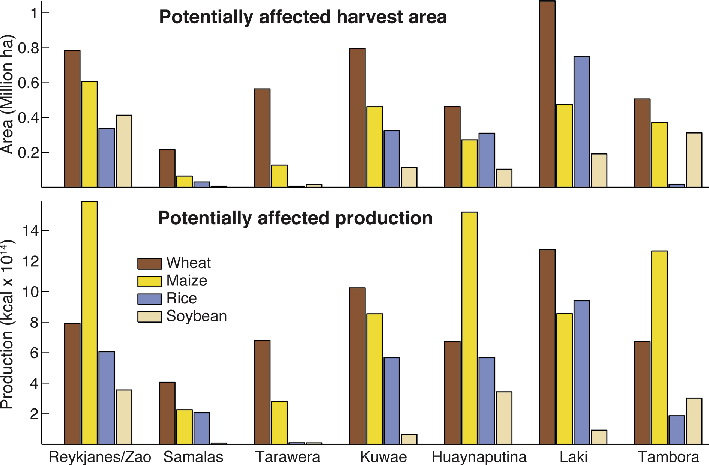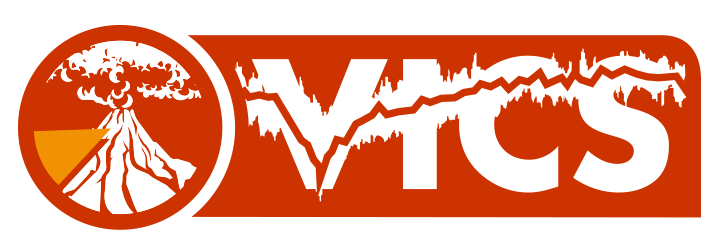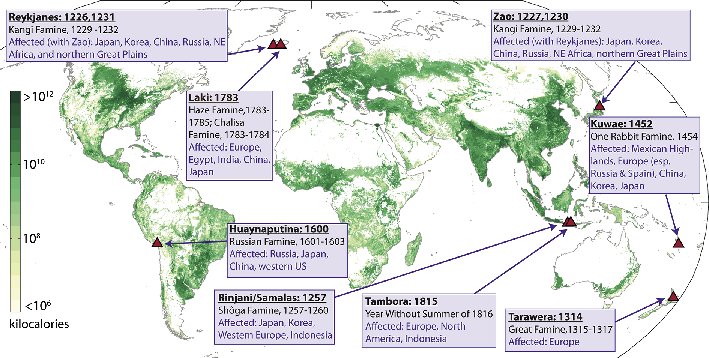- Home
- Publications
- PAGES Magazine
- Exploring The Potential Impacts of Historic Volcanic Eruptions On The Contemporary Global Food System
Exploring the potential impacts of historic volcanic eruptions on the contemporary global food system
Michael J. Puma, S. Chon and Y. Wada
Past Global Changes Magazine
23(2)
66-67
2015
Michael J. Puma1,2, S. Chon3 and Y. Wada1,2
A better understanding of volcanic impacts on crops is urgently needed, as volcanic eruptions and the associated climate anomalies can cause unanticipated shocks to food production. Such shocks are a major concern given the fragility of the global food system.
Our global food system will face great pressures in the coming decades due to increases in food demand, depletion of groundwater resources in major agricultural regions, and possibly more extreme weather anomalies as the climate changes (e.g. Godfray et al. 2010; Foley et al. 2011). A suite of strategies has been proposed to deal with these challenges, which includes increasing crop yields on underperforming lands, improving the efficiency of agricultural resources use (i.e. water, fertilizers and pesticides), changing diets, and reducing food waste (Foley et al. 2011). While these strategies are sound, they do not directly address the vulnerability of the global food system to major food supply disruptions.
Any substantial disruption to the world’s food supply would, all else being equal, lead to spikes in food prices. International food trade is vulnerable to such price fluctuations, especially because countries are likely to impose trade restrictions to protect domestic markets (as happened during the 2008 global food crisis). Such trade restrictions could propagate through the system, causing a systemic disruption to global food supply. Consequently, catastrophic shortages in national-level food supply can occur, because many countries depend on international trade for even their staple food supply (Puma et al. 2015). From this perspective, the global food system can be regarded as a fragile system that is susceptible to systemic disruptions.
Extremes and volcanic eruptions
Crops are highly sensitive to extreme climate anomalies including floods, droughts, and high and low temperatures. Farmers do have the ability to deal with some weather and inter-annual climate variability, depending on local farming practices, infrastructure, and experience (Gornall et al. 2010). However, there are important limits to their coping capacity. For example, if sudden temperature extremes coincide with critical stages of plant development (e.g. the flowering stage), crop yields reduce dramatically (e.g. Gornall et al. 2010). Likewise, regional precipitation shifts in monsoon Asia can lead to substantial crop losses, especially considering the highly concentrated rice production in this region.
Large volcanic eruptions are known to cause extreme climate and weather variations (e.g. Volcanic Explosivity Index, VEI ≥ 4); however, the climate response is known to vary substantially (e.g. Kasatkina et al. 2013), depending on numerous factors including the location of the volcanic eruption, the eruption’s VEI, the timing and duration of the eruption, and the baseline state of the climate system (e.g. El Niño Southern Oscillation (ENSO) or Pacific Decadal Oscillation phase).
Methods
We explore the potential impacts of historic volcanic eruptions on the contemporary global food system by: (1) selecting major volcanic eruptions over the past millennium that likely contributed to climate anomalies associated with significant crop failures; (2) identifying the geographic regions that were impacted by the associated climate anomalies; and (3) estimating present-day crop production that would potentially be affected based on the historical extent of these anomalies.
 |
|
Figure 2: Potential impacts of historical volcanic eruptions on contemporary global wheat, maize, rice, and soybean. (Top) Harvest area and (bottom) crop production that would potentially be affected if the severe historical weather anomalies, associated with the identified historical volcanic eruptions, affected each crop. To put these numbers in perspective, the potential annual production losses from the Laki eruption are equivalent to the annual food consumption of 2.9 billion people on a caloric basis, assuming a diet of 2940 kcal per capita per day (world average for 2015; www.who.int/nutrition/topics/3_foodconsumption/en/). |
To estimate the potentially affected crop production, we use the Spatial Production Allocation Model (SPAM; You et al. 2014). This model produces an estimate of global harvest area and crop production for 42 crop groups at a five-minute resolution for the year 2005. These production estimates are in metric tons, which we then convert to calories in order to aggregate the different crop groups. In Figure 1, we present total crop production for the world’s main food crops (wheat, maize, rice, soybean, potato, cassava, etc.). Next, we compute the potential impacts by identifying regions that experienced historic crop failures and then summing modern-day country-level harvest area and production values for the set of affected countries (Fig. 2).
Selected historical events
We select a total of seven historical periods with widespread weather extremes and crop losses that have been linked to volcanic eruptions (Fig. 1). We emphasize that these volcanic eruptions were not likely the sole cause of the weather anomalies. The interactions of volcanic emissions with large-scale climate patterns such as ENSO are likely to have contributed to each event.
The earliest period of major crop losses and famine that we consider is AD 1227-1232 (Atwell 2001). Three volcanoes, in particular, are thought to have contributed to climate anomalies: Iceland’s Mt. Reykjanes and Mt. Reykjaneshryggur erupted in 1226 and 1231, respectively, and Japan’s Mt. Zao in Japan erupted in AD 1227 and 1230. Extreme flooding, drought, and temperature fluctuations impacted crop production throughout the Northern Hemisphere. Later in the 13th century, another period (AD 1257-1260) of anomalous climate occurred in response to the 1257 eruption of the Samalas volcano on Lombok Island, Indonesia (Lavigne et al. 2013). Contemporary historical sources reveal that an unprecedented cold summer and extreme flooding affected crops throughout Western Europe and part of Asia (Stothers 2000).
One of the more speculative connections is the link between the multi-year eruption episode of Mt. Tarawera (Nairn et al. 2004) and Europe’s Great Famine of AD 1315-1317. During this period, anomalous wet and cool conditions devastated crops throughout Europe, especially the torrential downpours of the summer of 1315 (Lucas 1930). A better link has been established between the eruption of Mt. Kuwae, Vanuatu and weather anomalies in Europe, East Asia, and Mexico, although a strong warm ENSO event and other volcanic activity could jointly be responsible for the anomalies (Briffa et al. 1998; Atwell 2001). Later, Peru’s Mt. Huaynaputina erupted in 1601, which likely contributed to what might have been the coldest Northern Hemisphere summer in the past 600 years (Atwell 2001).
The most recent volcanic eruptions considered here are Iceland’s Laki and Indonesia’s Tambora eruptions. The 1783 Laki eruption produced a dry fog veil that spread throughout much of the Northern Hemisphere, causing unusual and extreme weather throughout (Thordarson 2009). In 1815, Tambora erupted resulting in severe local and global impacts. In North America and Europe, the summer of 1816 was extremely cold, resulting in a devastating famine throughout Europe (Oppenheimer 2003).
Possible impacts on today’s crops
In Figure 2, we present the harvest area and production of the world’s major crops (wheat, maize, rice and soybean) that would be potentially affected by each of the historical volcanic eruptions should they happen today. Potential crop impacts vary substantially across the volcanic events, depending on spatial distribution of the climate anomalies and crop production. For example, the impacts of the Mt. Reykjanes and Zao eruptions would potentially be greatest for maize, while the Laki eruption would be largest for wheat and rice. Although we would generally not expect total crop failure, even if failure in the affected regions were a small percentage (say 10%), we should expect to see spikes in global food prices.
Outlook
Volcanic eruptions are a threat to the global food system. History has shown that these sudden, unpredictable events can severely disrupt crop production across the globe. Unfortunately, the global food system is not well-positioned to deal with such disruptions, especially considering the tight relationship between global food supply and demand (Rosegrant et al. 2013). New research is needed, which combines our understanding of the global food system as a complex interconnected network with our improving insight into volcanic impacts on climate and crops. These findings must then be incorporated into food policies at the national and global levels.
affiliations
1Center for Climate Systems Research, Columbia University, New York, USA
2NASA Goddard Institute for Space Studies, New York, USA
3Korea Volunteer Organization International, Jongno-gu Seoul, Republic of Korea
contact
Michael J. Puma: mjp38 columbia.edu
columbia.edu
references
Atwell WS (2001) J World Hist 12: 29-98
Briffa KR et al. (1998) Nature 393: 450-455
Foley JA et al. (2011) Nature 478: 337-342
Godfray HC et al. (2010) Science 327: 812-818
Gornall J et al. (2010) Phil Trans R Soc B 365: 2973-2989
Kasatkina E et al. (2013) Izv Atmos Ocean Phys 49: 432-438
Lavigne F et al. (2013) Proc Natl Acad Sci USA 110: 16742-16747
Lucas HS (1930) Speculum 5: 343-377
Nairn I et al. (2004) J Volcanol Geotherm Res 131: 265-294
Oppenheimer C (2003) Prog Phys Geogr 27: 230-259
Puma MJ et al. (2015) Environ Res Lett 10, doi: 10.1088/1748-9326/10/2/024007
Rosegrant MW et al. (2013) Am J Agric Econ 95: 303-309

